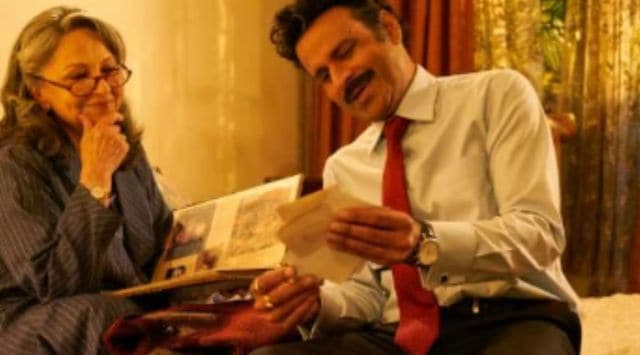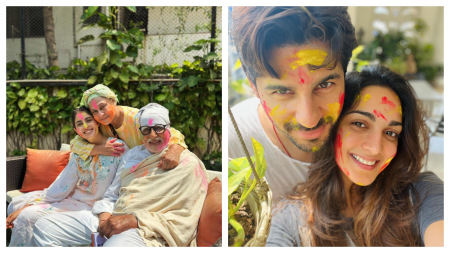- India
- International
What Rahul V Chittella’s Gulmohar teaches us about accepting change
Gulmohar reminds us that both acceptance and boundaries are necessary for surviving change.
 In Gulmohar, the theme of embracing change is all encompassing but not in an unsettling or overwhelming way.
In Gulmohar, the theme of embracing change is all encompassing but not in an unsettling or overwhelming way. Rahul V Chittella’s Gulmohar is a graceful, sensitive and a sincere film that deserves a large and attentive audience in dire need of some cinematic chicken soup. It cuts across generations and celebrates universal human behaviour. As the movie begins, we plunge into the middle of a dinner at “Gulmohar Villa” where we are introduced to different members of the Batra family as they prepare to shift from their Lutyens Delhi bungalow to a plush Gurugram penthouse, after the matriarch, Kusum (Sharmila Tagore) seals the deal on the sale of the house.
The Batras are by no means uncomplicated. It is at the end of dinner, out of the blue and without preamble, the high drama of Gulmohar begins when Kusum announces that she has bought a small house in Puducherry and plans to move there. What ensues thereafter are seismic changes and domestic upheavals. It’s a terrific opening gambit and Tagore plays it with aplomb.
The key players are Kusum, her adopted son Arun (Manoj Bajpayee), his wife Indu (Simran), their son Aditya (Suraj Sharma) and their musical daughter Amu (Utsavi Jha). Then there is Sudhakar (Amol Palekar) who plays the perfect foil to Kusum’s well-guarded secret. All of the characters speak Hindi, switching into occasional English, typical of modern middle-class Delhi families. Chittella masterfully propels the story through intimate and candid dialogues amongst family members, punctuated by poignant silences and bursts of charm, carefully saving the film from a conventional tone and pitch of a soap opera.
Chittella uses Gulmohar to examine impermanence, the anxiety of acceptance, complexity of sexuality, the dynamics of upstairs-downstairs, confused feelings, closeted skeletons, angst of the new generation and the resilience of a city which stoically bears the pulls and push of globalisation. The theme, however, of galvanising relevance is the need to accept our elders as “individuals with needs and desires” who cannot be guilt-tripped for prioritising themselves and be reduced to lonely figures of Edward Hopper paintings.
Arun shares a cozy relationship with his family and is a devoted son to his parents. He is the “centre” that wants to hold. He is comfortable being an adopted son till he is confronted with a brutal revelation that exposes his vulnerability and inner turmoil. His disappointment is further compounded by his son’s non-conformist show of strength. Arun’s urgent desperation to hold on to his family and his emotional disarray in the face of a crushing realisation is effortlessly anchored by the commanding performance of Bajpayee. Under a calm surface, he is far from healed. Catharsis is a powerful medicine, rendered palatably by the consummate artistry and folksy charisma of Bajpayee.

Tagore carries the film with her immaculately played Kusum, free from all baggage or expectation. The tiniest biting of her lip, an arch angling of the head, the folding of her arms somewhere between helpless and defensive, Tagore dances her way through conflicting emotions giving us a fully rounded portrait of her character.
Like her off-screen self, Tagore doesn’t race against time, therefore doesn’t lose. Tagore’s Kusum is an extension of Tagore’s quiet feminism. She’s decisive, emancipated, respects boundaries, shares close friendships with men, enjoys her brandy and marches to her inner drum while remaining tender and responsible. She is emotional without being meek. Still at the peak of her power, Tagore delivers an emotionally compelling performance of such quiet conviction that it scarcely looks like acting at all.
In a well-crafted scene with Amu, Kusum murmurs her secret and tends her wound with an uncanny honesty. In that, her appeal is so sincere that something catches in your chest. Kusum manages to keep one foot firmly on the floor even as she navigates complex minefields in which anxiety and openness about her well-kept past collide.
There is a key scene in the climax where Kusum confronts Sudhakar with terse quips and immense personal reserve. She is firm but carries a strain of melancholia, throughout maintaining a precisely choreographed physicality. Here she reminded me of Akira Kurosawa’s, “fire within and calm without”. The manner in which she offers him a sharp counterpoint to his strident confidence without any vestige of preachiness, is pure gold. Through this balancing act, Tagore provides the emotional fulcrum on which the drama turns. Sudhakar makes for a refreshing antagonist. He is unyielding and has sharp edges– but he is without malice.
It is probably too early in his career to say, but there aren’t too many filmmakers who pummel the viewer’s sensibilities through a generous doze of empathy like Chittella manages to. His astute perceptiveness prevents him from indulging in a fancy exercise in eloquence. Utterly believable and controlled, it will evoke instant resonance with similarly placed families everywhere.
The music of the film is memorable and compliments the storytelling. The warm widescreen lensing by Eeshit Narain is notable for its keen visual engagement featuring many unhurried close-ups, giving each character their own side-story worth our emotional investment.
Casting in supporting roles is equally meticulous, with top notch performances all around even where there is limited exposure. Suraj Sharma creates a tart edge and juggles the affectionate and abrasive infusing it with just the right amount of reality. He is stubborn in his determination to get his start-up running and allows us to have a full sense of what drives him and what his demons are, without being infantile.
Utsavi Jha and Kaveri Seth make for impressive debuts, marvellously channeling the story, but it was Simran Bagga who leaves an indelible impression. Simran handles Indu with superb finesse. Her careful self-control, gravitas and depth coupled with a wealth of nuance and subtlety makes Gulmohar a richer experience. I cannot wait to see more of Simran Bagga.
I wish Chittella had delved a little more in the relationship between Kusum and Indu and allowed Aditya to share his angst with his sensible and supportive mother Indu rather than gain perspective through the only “filmy’ scene in the film, where he is interrupted in his job interview by his otherwise calibrated wife. Though Kaveri Seth nails that scene, it could have been a little less melodramatic had sense prevailed through other channels. Also, how the Batra family daughter-in-law Indu breaks into Tamilian with Reshma, the house help, is without context.
The Gulmohar tree is a universal symbol of spring that reminds us that winter is far behind. Rhythm of season dances on – blooming – fading and blooming again. And with it so do our lives. Holding back what may no longer be in our control becomes futile. In Gulmohar, the theme of embracing change is all encompassing but not in an unsettling or overwhelming way. It gently reminds us that both acceptance and boundaries are necessary for surviving change.
The writer is an Indian Foreign Service officer and former lawyer at Shardul Amarchand Mangaldas.
Click for more updates and latest Bollywood news along with Entertainment updates. Also get latest news and top headlines from India and around the world at The Indian Express.
Photos
Apr 26: Latest News
- 01
- 02
- 03
- 04
- 05









































